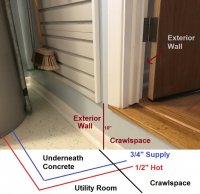Hi all,
I recently swapped out all the old 1960s galvanized steel piping in my crawlspace and replaced with Uponor PEX.
Unfortunately, there is a small bit of galvanized remaining that runs from the crawlspace wall into the utility room where the water heater is located. The utility room is on a concrete slab, and the original galvanized steel supply and hot lines are run *underneath* this slab - the lines do not appear to be encased in the concrete.
I'd like to replace this last bit of galvanized for two reasons. First, because it is galvanized and needs to be replaced at some point. Second, the hot line is 1/2" and this limits flow to my new (only) shower with two showerheads (5 gal/min combined).
I'm looking for ideas on how to replace this last bit of galvanized. My guess is that the most obvious solution is to tear up the concrete in the utility room, but I'd very much prefer to not do that.
Another solution might be to drill two holes into the floor joist at the slab/crawlspace transition. I have attached a photo of what this looks like. As you can see, there is about 10" between the concrete floor in the utility and the door threshold/floor of the home; this is where the 2x10 floor framing is, and is directly above where the current water lines (under the concrete) enter the utility room from the crawlspace. If I drilled two holes from the crawlspace into the utility room here, I could route the new lines inside the utility room, along the wall, to the water heater.
The only problem I see with that solution is that the crawlspace ends at the same point as the door (there is an exterior wall in the utility room that extends past the home's foundation/crawlspace). In other words, I would have to drill the access holes into the utility room directly below the door to the utility room, and this would obviously create an access problem. I could cover up the new lines with a step or protective box or something, but this still seems like a less than perfect solution.
Any other ideas? Should I consider running the lines outside of the house (below ground or possibly even above ground) and entering the utility room from the exterior wall?
Thanks for reading!!!
I recently swapped out all the old 1960s galvanized steel piping in my crawlspace and replaced with Uponor PEX.
Unfortunately, there is a small bit of galvanized remaining that runs from the crawlspace wall into the utility room where the water heater is located. The utility room is on a concrete slab, and the original galvanized steel supply and hot lines are run *underneath* this slab - the lines do not appear to be encased in the concrete.
I'd like to replace this last bit of galvanized for two reasons. First, because it is galvanized and needs to be replaced at some point. Second, the hot line is 1/2" and this limits flow to my new (only) shower with two showerheads (5 gal/min combined).
I'm looking for ideas on how to replace this last bit of galvanized. My guess is that the most obvious solution is to tear up the concrete in the utility room, but I'd very much prefer to not do that.
Another solution might be to drill two holes into the floor joist at the slab/crawlspace transition. I have attached a photo of what this looks like. As you can see, there is about 10" between the concrete floor in the utility and the door threshold/floor of the home; this is where the 2x10 floor framing is, and is directly above where the current water lines (under the concrete) enter the utility room from the crawlspace. If I drilled two holes from the crawlspace into the utility room here, I could route the new lines inside the utility room, along the wall, to the water heater.
The only problem I see with that solution is that the crawlspace ends at the same point as the door (there is an exterior wall in the utility room that extends past the home's foundation/crawlspace). In other words, I would have to drill the access holes into the utility room directly below the door to the utility room, and this would obviously create an access problem. I could cover up the new lines with a step or protective box or something, but this still seems like a less than perfect solution.
Any other ideas? Should I consider running the lines outside of the house (below ground or possibly even above ground) and entering the utility room from the exterior wall?
Thanks for reading!!!

